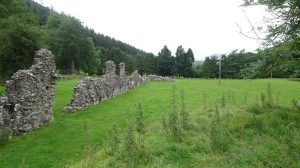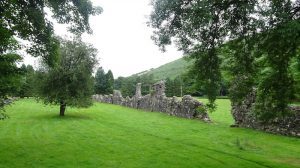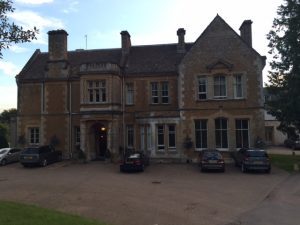S. Alexander O'Keefe's Blog, page 4
August 23, 2016
Revisiting Queen Guinevere’s Sanctuary
In my new book the The Return of Sir Percival, Guinevere, Queen of the Britons, and widow of the deceased Arthur Pendragon, has been forced to take refuge in a remote abbey, deep in the forest. This sanctuary offers the forlorn queen a measure of safety from the maelstrom of violence raging throughout the fallen kingdom, and a base from which to plan for the future, however bleak.
In my search for the ideal geographical location for this mythical abbey, I considered a number of alternatives, but ultimately decided upon the site of the former Cistercian abbey in mid-Wales, the Abbey Cwm Hir. All that remains of the abbey today, which was established in the twelfth century, is a haunting ruin located in a very small village bearing the same name.

The site of the former abbey seemed an ideal place for Guinevere to seek sanctuary for a number of reasons. It is truly remote, the valley and surrounding hills are magnificent, and a series of rivers run through the area, one of which I used in a particular scene in the book. In the story (which takes place long before the monastery was built), a much larger monastic compound is located on the site. It contains a convent, a church, a great hall, and four stone towers, connected by a formidable curtain wall.

A photo taken by my daughter Morgan of the ruins of the Abbey Cwm Hir in mid-Wales
This was the destination that my daughter Morgan and I visited, on the third day of our visit to the U.K. In the next post, I will describe this location in more detail, provide details of our meeting with the caretaker, Melwynn, and share more photographs.
August 16, 2016
On the trail of the last Knight – Londinium to Isca Augusta
This post is part of a series. It chronicles my recent fourteen hundred mile journey through England, Wales and Scotland. During this trip, my daughter Morgan (a 21-year old Theatre student at Concordia University in Irvine) and I visited most of the key sites that appear in my latest novel, The Return of Sir Percival . To read from the beginning of the series you can start with the first post.
After landing at Heathrow, Morgan and I embarked on our epic (from our perspective) mission – retracing the path of the last Knight of the Round Table upon his return to a war-torn Albion, seven years after the death of Arthur Pendragon. In truth, our travel itinerary was the reverse of what occurs in the story, due to time constraints and other factors. If you look at the map that appears in the book, you can track our basic route (we also drove north and spent time in Edinburgh).
Our first destination was the Cotswolds, a rural area in south central England, renowned for its beautiful rolling hills, and quaint towns and villages. This location was geographically on the way to our first critical destination—Wales—and my brother Stephen and his family happened to staying there.
The first hour of driving, particularly in the Heathrow traffic, was difficult. The confluence of driving on the “wrong-side-of-the-road” (from an American perspective), the frequent roundabouts (I had a problem choosing the lane at the entry to each swirl that matched our designated exit out – presumably there was one) and the narrower roadways were difficult at first. However, I was able to “muddle through” without too many mishaps (e.g. periodically bumping the left curb with the left tire).

The Wyck House in the Cotswolds
We stayed at the Wyck House and Manor Hotel on the first night. It is located on a rise overlooking a magnificent expanse of land. In the above picture from the hotel grounds, you can almost see Sir Percival and his army marching southward, over the hills in the distance. On the next visit, I am going to stay awhile and spend more time hiking, and less time driving.
We stayed at the Three Ways Manor on the second night, which is located in a quaint town called Mickelton. Morgan and I had wonderful dinner there with my brother Steve, his wife Paula, and their son Thomas. Since we live on opposite coasts in the U.S., and only meet once a year generally, it was great to be able to get together.
After touring Mickelton in the morning, we drove south down the A429 to Circencester. Circencester appears on the map in the front of the book as Corinium, its Roman name. The A429 follows the track of a Roman road that appears in the book
Midway down the A429 we visited the ruins of a Roman Villa at Chedworth, which is located off the A429. It is quite a place, if you are an obsessive Roman history buff like me. The artwork on the walls and floors, and the luxurious bathing facilities (although much faded and still an archaeological work in progress) were amazing. At least some of the Roman/Briton elite lived like kings during the 300s.
After traveling through Cirencester, we drove northwest past the Roman settlement that appears as Isca on the map in the book (also known as Caerleon), on our way to the site of the ruins of the Abbey Cwm Hir. The next post in this series will cover my visit to the Abbey deep in Wales—Guinevere’s remote sanctuary in the novel.
August 9, 2016
Retracing the Steps of Sir Percival
My forthcoming book, The Return of Sir Percival, presents my vision of the iconic Arthurian legend that is known and beloved by so many throughout the world—a legend that is part myth, part reality. The historical King Arthur, if he existed (and some dispute his existence), was a Celtic-Briton (a warlord) who led his people in a heroic, but ultimately futile struggle against the invading Saxons and Angles.
In contrast, Arthur Pendragon, Queen Guinevere, and the Knights of the Round Table are from the realm of fantasy. The Return of Sir Percival attempts to weave the figures of Arthurian legend into the existential challenge facing the historical Arthur and his people, and to embed the story, to the extent possible, in an actual geographical and quasi-historical context – a post-Roman Briton circa roughly 600 A.D.
Sir Percival, and his fellow characters, journey on the actual Roman roads, reside, pass through and fight on actual geographic and (in most instances) historically viable sites. In choosing the locations used in the story, I had a plethora of options, given Britain’s rich history and geographic diversity. In those instances where a geographic or historical site was not historically ideal in some respects, such was the Abbey Cwm Hir (which was a Cistercian monastery established long after the seventh century), reality yielded to fantasy. For example, in the case of the Abbey, I assumed that an earlier much grander abbey existed on the site five hundred years before the Cistercian abbey that served the role assigned to in the book.
Some of the key sites that appear in the book are the Roman amphitheater in Londonium (what is left of this structure is visible in the museum under the Guild Hall in London), Abbey Cwm Hir in Wales (Guinevere’s sanctuary), a Roman coastal fort in what is now Felixstowe, England, (Morgana’s castle [this castle fell into the sea in the 18th century]), Pen Dinas in Wales (a hill to the south of Aberystywyth), the site where the River Wid crosses the Roman road that is now the A12 (near Chelmsford, England), Cestreforda (Great Chesterford, England), the Roman settlement of Calleva (Silchester, England), the Roman settlement of Corinium (Cirencester, England), and the Roman settlement at Noviomagus Reginorum (Chichester, England).
I recently visited most of these places with my daughter Morgan (who was my photographer and often guide), and I look forward to sharing some of these experiences in more depth with readers in later blogs, as well as photographs showing the views that Guinevere, Morgana, and Sir Percival would have seen, as they walked the paths I laid out for them in the tale.
August 4, 2012
It’s all about the details: Thoughts on background research
As a lawyer, I spend hours each day researching legal issues. Although the research covers different areas of the law (bankruptcy, commercial practice (contracts, UCC etc.), real estate etc.), it’s all basically in the same space. In contrast, the research that I have to do as thriller writer is all over the lot. For example, this morning I was researching high-end women’s and men’s clothing styles for two characters. I know very little about the first, and only moderately more about the second. However, since I have to outfit two particularly wealthy characters, I need some understanding of the specifics (sorry, I don’t watch the fashion-themed reality shows). Other research issues that have arisen during the writing process include the altitude ceiling of a particular helicopter, the flying range of private jets, the weapons used by a particular unit within a foreign army, and a host of geographical issues (e.g. finding an airport in a particular area of Mexico that has a runway long enough to land a Hercules C140). At the very end of the process, I double check the more exotic facts with the experts (fashionistas for clothes, weapons experts for the firearms, etc.) to make sure I hit the mark. Although I suspect that it would be more efficient to put in that kind of detail in the second (fifth, … twentieth) run through of the manuscript, I have trouble doing that. I will have to check with other writers to see how they navigate their way through the process.
July 28, 2012
Word-by-word, paragraph-by-paragraph: The unique burden of the author
As I sit here, slogging through page after page of my next book, I have come to a realization. For me, conceptualizing the story and the characters is not the most difficult task. I know story, in substantial measure, from start to finish (and in this instance it is a convoluted journey, with a host of twists and turns – maybe too many), although there are a few twists and turns that may have to be woven in along the way to make the tale a seamless and believable whole. I also know the characters that will play the roles in the story – most of them. For me, the difficult task is what I would call the “velocity” of character development: Trying to pace the evolution of the character without bogging down the story. People are incredibly complex, and I could easily spend ten consecutive pages creating a single personality, and still leave a hundred holes, but that would disrupt the flow of the story. So I have to try to develop each character, after the initial introduction, incrementally, balancing story flow and character evolution. I suspect that a great writer simply puts a pen to paper and it all flows together, without a ripple. That’s not me. I have to struggle through the process, paragraph-by-paragraph, page-by-page…
July 20, 2012
Background on Helius Legacy locations
A friend asked me how/why I chose the locales in the book where key action scenes occur, e.g., the helo assault on John Caine’s remote cabin in the San Bernardino mountains; the introduction of Paquin (the ruthless head of Helius Energy’s corporate security) through the scene in Douala, Cameroon; and chase scenes involving protagonists Andrea Marenna (the Texas lawyer) and John Caine in or around Austin, Texas. In the case of the San Bernadino mountain scene, I’ve hiked (or more appropriately I was dragooned into enduring these nine hour slogs by two good buddies who enjoy watching me in pain) Mt. Baldy, Mt. San Bernardino, Mt. San Gorgonio, and Mt. San Jacinto (Cactus-to-the-clouds – but only to the tram – almost died). The location offered the kind of wilderness venue that seemed perfect for the scene. In the case of Cameroon, I worked for a company years ago (law clerk) that discovered an oil reserve off the coast so I knew about the oil nexus. Insofar as Austin is concerned, I liked the place when I visited (although some of the more specific locations therein – the restaurants, etc., are fictional).
July 14, 2012
Two books that will satisfy any fellow history buff
I try to hike 3-5 hours every Sunday. This solitary time gives me a chance to get some exercise and listen to my audiobooks (on the IPhone). Each month I generally can work through at least two books. Last month I finished “The Vikings”, by Robert Ferguson (history), and “Ireland”, by Paul Johnson. The first book made it crystal clear that living on an island off the Irish coast circa 800 A.D. (or C.E.) was a Hobbesian experience – life being “nasty, brutish and short” (the Vikings, in addition to being savage killers, were also prodigious enslavers, and in fact it was apparently this trade that made them rich). The second book led me to conclude that there is very little about Irish history that is clear. What a maelstrom. Both were Interesting and informative books.
S. Alexander O'Keefe's Blog
- S. Alexander O'Keefe's profile
- 60 followers



